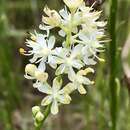Comments
provided by eFloras
Specimens of Triantha collected in Burlington County, New Jersey, have generally been determined as T. racemosa. However, the population is variable, and while there are aspects in some of these plants suggestive of T. racemosa that would explain the determinations, others are closer morphologically to T. glutinosa. This is seen in the typical “glutinosa” glands, the narrower, less-spreading bracteoles that usually lack glandular hairs, the more-ascending pedicels, the shorter internodes in most inflorescences, and the chartaceous capsules. I suppose that in the past the two species had overlapping ranges in this northeastern region where they no longer are found, and that some hybridization between T. glutinosa and T. racemosa has occurred. The Burlington County population is a surviving disjunct remnant with attributes of both species. The specimens have been annotated T. glutinosa × T. racemosa, and New Jersey is omitted from the list of states in which T. racemosa is found.
- license
- cc-by-nc-sa-3.0
- copyright
- Missouri Botanical Garden, 4344 Shaw Boulevard, St. Louis, MO, 63110 USA
Description
provided by eFloras
Stems leafless, or with 1–3 leaves towards base, 20–70 cm, coarsely glandular-pubescent below inflorescence. Leaf blades to 35 cm × 6 mm. Inflorescences racemose, 15–80-flowered, usually open, 3–22 cm; bracts subtending pedicel in cluster; bracteoles shallowly 3-lobed or cleft from proximal 1/3 to base, lobes acute or rounded, usually glandular. Flowers borne in clusters of (2–)3(–7), proximal sometimes remote; perianth white, drying orange; tepals 2.5–5 mm, inner series narrower, longer; stamens 2.5–4.5 mm; ovary ellipsoid to cylindrical, usually tapering abruptly to style base, forming rounded shoulder; styles connate basally into column 1/4–2/3 their length, 1–1.8 mm; pedicel 2–12 mm. Capsules ovoid to subglobose, 3–5 mm, ± equaling or slightly longer than tepals and ± enclosed by them, hard. Seeds reddish brown, ca. 1 mm; appendages 1 or 2 with one at one end ca. 1/2 to equaling seed, one at opposite end often much shorter; coat absent.
- license
- cc-by-nc-sa-3.0
- copyright
- Missouri Botanical Garden, 4344 Shaw Boulevard, St. Louis, MO, 63110 USA
Distribution
provided by eFloras
Ala., Del., D.C., Fla., Ga., La., Md., Miss., Tex., Va.
- license
- cc-by-nc-sa-3.0
- copyright
- Missouri Botanical Garden, 4344 Shaw Boulevard, St. Louis, MO, 63110 USA
Flowering/Fruiting
provided by eFloras
Flowering summer.
- license
- cc-by-nc-sa-3.0
- copyright
- Missouri Botanical Garden, 4344 Shaw Boulevard, St. Louis, MO, 63110 USA
Habitat
provided by eFloras
Boggy areas, pine barrens, savannas; 0--400m.
- license
- cc-by-nc-sa-3.0
- copyright
- Missouri Botanical Garden, 4344 Shaw Boulevard, St. Louis, MO, 63110 USA
Synonym
provided by eFloras
Melanthium racemosum Walter, Fl. Carol., 126. 1788; Tofieldia racemosa (Walter) Britton, Sterns & Poggenburg
- license
- cc-by-nc-sa-3.0
- copyright
- Missouri Botanical Garden, 4344 Shaw Boulevard, St. Louis, MO, 63110 USA
Triantha racemosa
provided by wikipedia EN
Triantha racemosa, commonly called the coastal false asphodel[1] or southern bog asphodel, is a species of flowering plant in the Tofieldia family. It is native to the Coastal Plain of the Southeastern United States, although there are a few disjunct populations inland. It is found in acidic wetlands, including wet barrens and savannas.
Triantha racemosa produces a raceme of white flowers in mid-summer. An intermediate population that suggests a transition to the more northern Triantha glutinosa is found in the New Jersey Pine Barrens.[2]
References

- license
- cc-by-sa-3.0
- copyright
- Wikipedia authors and editors
Triantha racemosa: Brief Summary
provided by wikipedia EN
Triantha racemosa, commonly called the coastal false asphodel or southern bog asphodel, is a species of flowering plant in the Tofieldia family. It is native to the Coastal Plain of the Southeastern United States, although there are a few disjunct populations inland. It is found in acidic wetlands, including wet barrens and savannas.
Triantha racemosa produces a raceme of white flowers in mid-summer. An intermediate population that suggests a transition to the more northern Triantha glutinosa is found in the New Jersey Pine Barrens.
- license
- cc-by-sa-3.0
- copyright
- Wikipedia authors and editors

